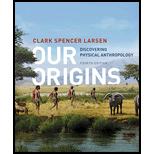
Concept explainers
Introduction: Primates, the group containing all species commonly related to lemurs, monkeys, and apes, are members of the biological order, and the latter category includes human beings.
Answer to Problem 1SQ
Correct answer: d. Rigidly connected, identical vertebrae in the backbone.
Explanation of Solution
Reason for the correct answer:
The species that live in and locomotes through the trees are referred to as arboreal adaptation. The primates have the characteristics of arboreal adaptations. The primates have immense diversity and they possess a distinctive body trunk. There are about five functional distinct types of vertebrae in the backbone of primates. The characteristic that is not shared by most of the primates is rigidly connected, identical vertebrae in the backbone.
Option d. is given as “rigidly connected, identical vertebrae in the backbone”.
Hence, the correct answer is option d.
Reasons for incorrect answers:
Option a. is given as “mobile joints, connecting bones of the shoulders, limbs, hands, and feet”.
Mobile joints, connecting bones of the shoulders, limb, hands, and feet are the characteristic features of the primates that make them good at living in trees. Therefore, option a is incorrect.
Option b. is given as “an opposable thumb and often an opposable big toe”.
The opposable thumb and big toe feature is the feature of primates that helps in arboreal adaptation shared by most of the primates. Therefore, option b is incorrect.
Option c. is given as “dermal ridges and flat nails on fingertips”.
The feature of dermal ridges and flat nails on the fingertips is shared by most of the primates in an arboreal adaptation. Therefore, option c is incorrect.
Hence, options a., b., and c. are incorrect.
The characteristic that is not an arboreal adaptation shared by most of the primates is provided.
Want to see more full solutions like this?
Chapter 6 Solutions
Our Origins: Discovering Physical Anthropology (Fourth Edition)
- Explain how the hormones of the glands listed below travel around the body to target organs and tissues : Pituitary gland Hypothalamus Thyroid Parathyroid Adrenal Pineal Pancreas(islets of langerhans) Gonads (testes and ovaries) Placentaarrow_forwardWhat are the functions of the hormones produced in the glands listed below: Pituitary gland Hypothalamus Thyroid Parathyroid Adrenal Pineal Pancreas(islets of langerhans) Gonads (testes and ovaries) Placentaarrow_forwardDescribe the hormones produced in the glands listed below: Pituitary gland Hypothalamus Thyroid Parathyroid Adrenal Pineal Pancreas(islets of langerhans) Gonads (testes and ovaries) Placentaarrow_forward
- Please help me calculate drug dosage from the following information: Patient weight: 35 pounds, so 15.9 kilograms (got this by dividing 35 pounds by 2.2 kilograms) Drug dose: 0.05mg/kg Drug concentration: 2mg/mLarrow_forwardA 25-year-old woman presents to the emergency department with a 2-day history of fever, chills, severe headache, and confusion. She recently returned from a trip to sub-Saharan Africa, where she did not take malaria prophylaxis. On examination, she is febrile (39.8°C/103.6°F) and hypotensive. Laboratory studies reveal hemoglobin of 8.0 g/dL, platelet count of 50,000/μL, and evidence of hemoglobinuria. A peripheral blood smear shows ring forms and banana-shaped gametocytes. Which of the following Plasmodium species is most likely responsible for her severe symptoms? A. Plasmodium vivax B. Plasmodium ovale C. Plasmodium malariae D. Plasmodium falciparumarrow_forwardStandard Concentration (caffeine) mg/L Absorbance Reading 10 0.322 20 0.697 40 1.535 60 2.520 80 3.100arrow_forward
- please draw in the answers, thank youarrow_forwarda. On this first grid, assume that the DNA and RNA templates are read left to right. DNA DNA mRNA codon tRNA anticodon polypeptide _strand strand C с A T G A U G C A TRP b. Now do this AGAIN assuming that the DNA and RNA templates are read right to left. DNA DNA strand strand C mRNA codon tRNA anticodon polypeptide 0 A T G A U G с A TRParrow_forwardplease answer all question below with the following answer choice, thank you!arrow_forward
 Biology (MindTap Course List)BiologyISBN:9781337392938Author:Eldra Solomon, Charles Martin, Diana W. Martin, Linda R. BergPublisher:Cengage Learning
Biology (MindTap Course List)BiologyISBN:9781337392938Author:Eldra Solomon, Charles Martin, Diana W. Martin, Linda R. BergPublisher:Cengage Learning
 Concepts of BiologyBiologyISBN:9781938168116Author:Samantha Fowler, Rebecca Roush, James WisePublisher:OpenStax College
Concepts of BiologyBiologyISBN:9781938168116Author:Samantha Fowler, Rebecca Roush, James WisePublisher:OpenStax College Human Biology (MindTap Course List)BiologyISBN:9781305112100Author:Cecie Starr, Beverly McMillanPublisher:Cengage Learning
Human Biology (MindTap Course List)BiologyISBN:9781305112100Author:Cecie Starr, Beverly McMillanPublisher:Cengage Learning Biology: The Dynamic Science (MindTap Course List)BiologyISBN:9781305389892Author:Peter J. Russell, Paul E. Hertz, Beverly McMillanPublisher:Cengage Learning
Biology: The Dynamic Science (MindTap Course List)BiologyISBN:9781305389892Author:Peter J. Russell, Paul E. Hertz, Beverly McMillanPublisher:Cengage Learning





